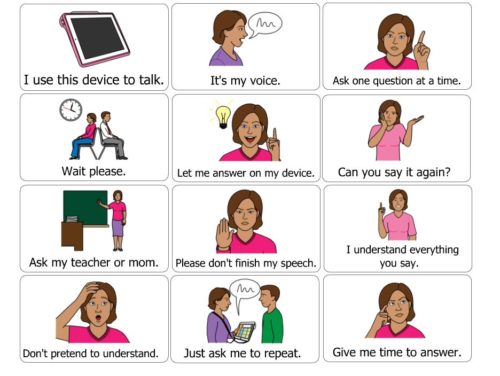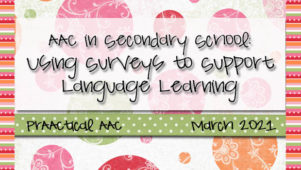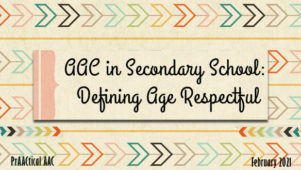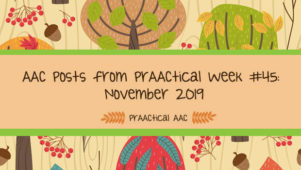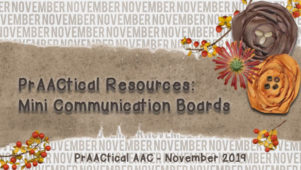How I Do It: Pocket Flipbooks for Teens
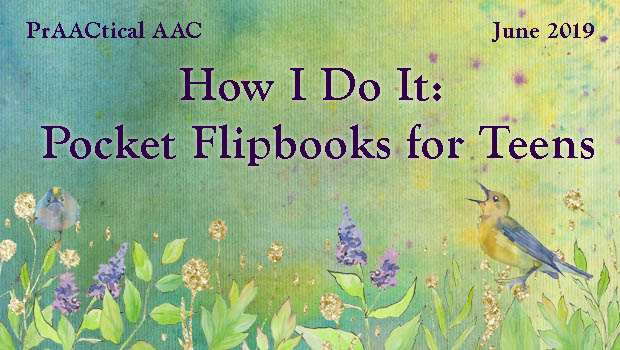
 Thanks to all who reached out to express appreciation for Katherine Dally’s series on making and using flipbooks for adults and teenagers with complex communication. Today, she continues that series with a case example of how she used this to support a young woman who communicates through multiple modalities, including an SGD. Katherine is an SLP who works both as an AT consultant for an educational service center and as a home health SLP serving adults with neurological conditions in Ohio. We’re grateful to Katherine for sharing her experiences and for the downloadable materials that are linked at the end of her post
Thanks to all who reached out to express appreciation for Katherine Dally’s series on making and using flipbooks for adults and teenagers with complex communication. Today, she continues that series with a case example of how she used this to support a young woman who communicates through multiple modalities, including an SGD. Katherine is an SLP who works both as an AT consultant for an educational service center and as a home health SLP serving adults with neurological conditions in Ohio. We’re grateful to Katherine for sharing her experiences and for the downloadable materials that are linked at the end of her post
If you missed her previous posts in this series, you may want to check those out: How I Do It – Pocket Flipbooks for Adults & Teens: Part 1, Part 2.
::::::::::::::::::::::::::::::::::::::::::::::::::::::::::::::::::::::::::::::::::::::::::::::::::::::::::::::::::::
How I Do It: Pocket Flipbooks for Teens
Let’s go through a teen case example for the pocket flip book focusing on the client-centered approach, problem-solving stage, and creation.
Background
Jamie is a senior in high school in a transition to work program. Her overall goal at the end of the year is graduation and finding a job in the community. She is social, outgoing, loves to help others, and eager to talk to anyone. She uses a dedicated communication device via touch secondary to severe speech intelligibility. The device is worn with a shoulder strap like a purse.
She does attempt to communicate verbally. However, at best she is understood 25% of the time when the topic is known. She travels out in the community daily with teachers and classmates to grocery stores, bowling alleys, nursing homes among other locations. The staff at school and family want to make sure when she obtains a job or heads out in the community on day trips, she can effectively communicate to others and others know how to communicate with her.
Client Centered Chart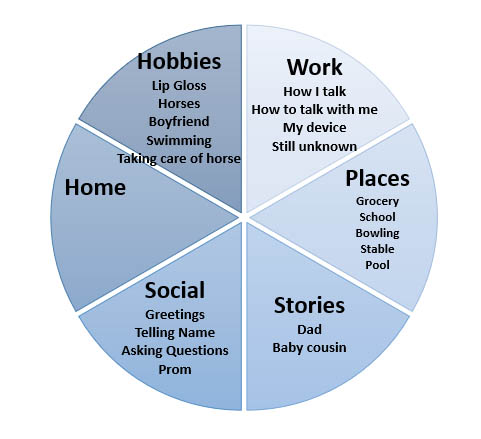
Once again, we turn to the wonderful work of Sarah Baar at Honeycomb Speech Therapy in creating a pie chart representing her message needs. For Jamie, the most important sections on her chart were work and places. She was able to communicate most information through her device. However, the imperative part was giving her the opportunity to do so.
The following communication flip book was created for Jamie, with the goal to tell others how she communicates and how others can best communicate with her upon initial meetings with communication partners or in new environments. Jamie was actively involved in choosing the communication content for this and for her high tech AAC device.
Important Phrases
- I use this device to talk.
- It’s my voice.
- Ask one question at a time.
- Give me time to answer.
- Let me answer on my device.
Location of the pocket flip book
Jamie wears her communication device across her chest using a shoulder strap. The flip book will clip on to the strap and hang near her communication device. She can easily pull up the communication flip book or take it off the strap by unlocking the key ring. Initially, the flipbook would be simple, implementing four to five phrases with the goal to add more phrases as she gains practice and familiarity.
You can download the file for this flipbook here.
Filed under: Featured Posts, PrAACtical Thinking
Tagged With: communication book, flip book, teens
This post was written by Carole Zangari
